The Stolen Queen: A Mystery Whodunnit Set in the Met Museum
Author Fiona Davis shares the inspiration for her latest historical fiction novel set in NYC!


Surrounding restaurants, shops, sidewalks, and parklets seem perpetually busy as the neighborhood becomes the destination it was long meant to be. The saga of how this came about is laid out by former president Reynold Levy in his Game-of-Thrones-like chronicle, They Told Me not to Take that Job: Tumult, Betrayal, Heroics, and the Transformation of Lincoln Center.
New Yorkers have so thoroughly made the new Lincoln Center their own that it can be hard to remember what was once there (including a lost neighborhood of San Juan Hill),—and therefore the subtle genius of what’s been done.
Here are a few things you might not know about the new Lincoln Center:
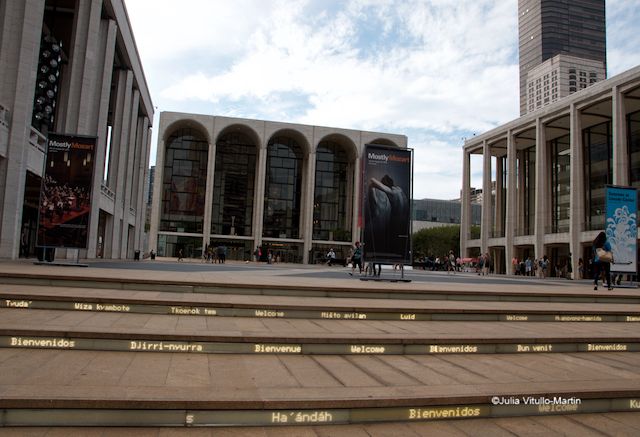 The Josie Robertson Plaza has a new staircase with welcoming LED lights.
The Josie Robertson Plaza has a new staircase with welcoming LED lights.
In the $1.2 billion renovation overseen by Diller Scofidio + Renfro, the new Lincoln Center is determined to welcome you in every conceivable way. While not everyone loves the LED lights on the 171-foot-wide grand stairs spelling out “bienvenue” in multiple languages, the new wayfinding signage, or the perky pink pingpong-paddle-like signs, they represent a distinctive approach that seems to work. Glass canopies leading to Avery Fisher Hall and the David Koch Theatre flank the stairs. More important for our age of pedestrian-access, the staircase covers an underground drop-off road for cars, introducing to Lincoln CEnter Frederick Law Olmsted‘s crucial principle of separating different modes of traffic.
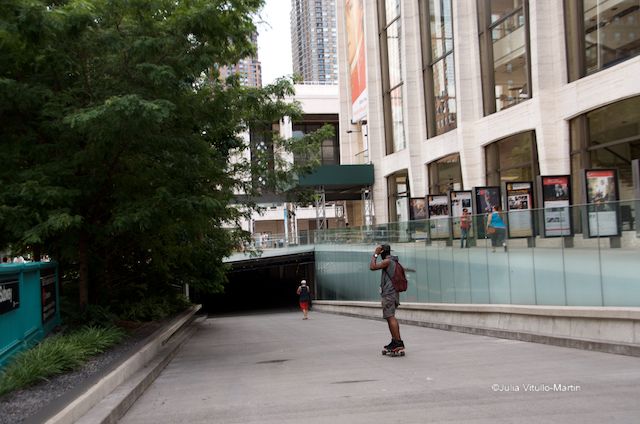 Underpass beneath Josie Robertson Plaza
Underpass beneath Josie Robertson Plaza
In the old days, if you were heading for Lincoln Enter from the east side of Broadway, you had to negotiate 11 lanes of traffic to make it to the sidewalk, walk up a few steps, and cross two lines of cars as they dropped off and picked up patrons. Pedestrians huddled and raced, dodging dangerous traffic and hoping for the best as limos and taxis juggled to reach the curb of the original access drive that ran the length of the east side of Avery Fisher Hall, Josie Robertson Plaza, and the New York State Theatre.
Now the access drive, renamed the Roslyn and Elliot Jaffe Family Drive, is buried. No more cars on the plaza, marring the view or mowing down patrons. Even those arriving by car are happy, as they alight into a protected, concourse-level porte corchère yielding direct (and ADA compliant) access to the theatre. There have even been art exhibits, dance parties and film sets in the drive–a true multi-purpose piece of infrastructure.
It’s a win for all. One odd problem: signage is almost nonexistent, with the result that drivers get confused about how to enter and worried that they won’t be able to exit. Next steps: add signage and pretty up the drive.

Tully’s complex glass wall reflects traffic on 65th Street.
Alice Tully, a concert hall that hadn’t been renovated since its 1969 opening, was originally a concrete Brutalist building designed by architect Pietro Belluschi for a very different era in which high arts like chamber music maintained an existence removed from the general public. Today, splendid classical musicians play on New York City’s streets and in subway stations, and the strains of Brahms and Beethoven are familiar and loved. Thus it’s only right that Tully’s once hard-to-find main entrance has been demolished and replaced with a 3-story, all-glass grand foyer and open public plaza beneath the Juilliard School’s transparent new facade and cantilevered canopy.

Inside Alice Tully Hall

View of American Table from a cantilevered viewing spot in Alice Tully Hall
Marcus Samuelsson has opened an immensely popular American Table, which emphasizes regional influences. Inside, the new Tully has what the NYT calls a “womblike performance space, its surfaces flush with new life,” in part because of the enveloping wood, cut from a single African moabi tree. Or, as Anthony Tommasini wrote in praise of FXFowle Architects, Tully’s “Starr Theater, though not any smaller, now feels intimate and warm.”

Alice Tully Hall now embraces and mirrors NYC

Blades on 65th Street: Jazz at LC, Juilliard, King and I
Even though Lincoln Center reaped tremendous revenue from its underground parking garages—among the largest in NYC—it gave up 100 parking spaces as it reconfigured 65th Street. Levy points out it converted what had been a long stretch of garage entrances and exits, loading docks, and service corridors into an inviting, foot-trafic friendly street of the arts. It’s an amazing achievement that may be lost to history as memories of the old, dark, hostile, car-clogged street fade.

And look at what we have now: a wide, pedestrian-friendly sidewalk with round-the-clock blades providing much-needed light as well as information and beauty. One series of blades features current star performers, another iconic images such as hands clapping or conducting, and yet another dramatic images of different programs, such as Head Shots or Theatre of Nations. Some blades are informational, giving ticket availability and performance dates. Often one compelling image with no words—musicians playing or a dancer dancing—is repeated the length of the street, providing an elegant unity. The side of the blades facing oncoming traffic have far more subdued lighting and design than those facing east, for safety reasons. This is the new Lincoln Center: simultaneously helpful, practical, welcoming, and gorgeous.
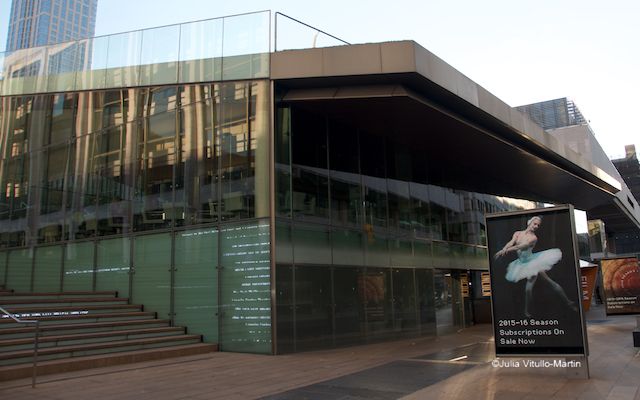 Lincoln Ristorante can be entered from 65th Street or LC itself.
Lincoln Ristorante can be entered from 65th Street or LC itself.
The post-World War II planning idea that commercial enterprises have no place in nonprofit spaces ruinously undermined the urban vibrancy of many neighborhoods. Few nonprofits have thrown that principle over with as much gusto as the new Lincoln Center, which has imaginatively incorporated food, drink, and sociable seating into its operations.
The bar and lovely terrace of the Claire Tow Theatre, for example, is open to ticket holders one hour before curtain, and stays open one hour after, serving specialty cocktails and small plates. ‘wichcraft Cafe in the David Rubenstein Atrium, Indie Food & Wine in the the Film Society, American Table in Alice Tully, and the Lincoln Center Kitchen in Avery Fisher all serve moderately priced seasonal fresh food.
But the glamorous star of Lincoln Center’s eating scene is Lincoln Ristorante, centrally sited where a brutal concrete wall once stood. Called a “dazzling postmodern dining palace” by New York Magazine, Lincoln is in turn dazzlingly expensive. It makes up for this a bit by offering an excellent Restaurant Week lunch and other occasional specials. It also, says Levy, provides Linoln Center a handsome 6-figure annual rent guarantee plus a percentage of gross sales above certain million-dollar thresholds.
For slightly more affordable fare, there’s also the traditional Grand Tier Restaurant inside the Metropolitan Opera where you can return after dinner to get your dessert and coffee during intermission.

Dancers cross the Reynold Levy Bridge to the Juilliard School and School of American Ballet
As Robin Pogrebin wrote in the New York Times, “It’s not so much the mounds of debris in Alice Tully Hall’s lobby or the churned-up pavement next to the Juilliard School that seem so startling these days at Lincoln Center. It’s what you will soon see for the first time in decades when you glance up from the middle of West 65th Street: the sky.” Ah, the sky, blocked for so long but now one of Lincoln Center’ finest features.

The North Plaza, with the Hypar Pavilion on the left and Henry Moore’s Reclining Figure in the Milstein Pool, has been radically redone.
Attacking the old Lincoln Center’s “social fusion and alienation” that could “only be construed as failure,” architect Elizabeth Diller argued that the tranquility and abstract simplicity of Dan Kiley’s original North Court had deteriorated into an ugly expanse of hard surfaces that couldn’t be easily fixed. Kiley’s planters and elegant paving stones had been allowed to decay, and his quartet of London plane trees had been replaced with single plantings of pear trees.
Her hope was to preserve Kiley’s intent by making the area into a “social condenser,” a Soviet constructivist idea that public spaces can influence behavior by breaking down hierarchies and creating socially equitable spaces. Oddly, this old Soviet idea seems to work. As admirers of Kiley, we are sad to see so little left of his landscape. And the preservationists are surely correct that Kiley’s landscape became overgrown, abandoned, and destroyed because of a lack of understanding of its merits by the city and a lack of maintenance by the agencies in charge. These issues of preservation and change are worthy of further public discussion, but in the meantime the market response to the new North Plaza is overwhelmingly favorable.

Quebe Sisters Band at Lincoln Center OutofDoors
Having just closed its 45th season, Lincoln Center OutofDoors offered three weeks of extraordinary music and dance by the most celebrated musicians on the planet, and all for free, no tickets necessary.
All three Lincoln Center theatres participate in LincTix, which makes tickets available at $32 to 21-35 year olds. The Claire Tow Theater, also called LCT3, produces shows by new playwrights, directors, and designers, and is dedicated to attracting new, young audiences. It has had several hits, including Preludes and Disgraced, and is offering tickets at $30 for its next production, Kill Floor. The New York City Ballet offers $29 day-of tickets to anyone 29 years or younger, starting the week of September 22.

And, then, of course there are the ongoing, often thrilling free performances of young dancers and musicians practicing for themselves and one another, indifferent to but tolerant of their admiring public.

Dancers stretching on west wall of Metropolitan Opera
 Photograph used with permission from Ryan Southen Photography
Photograph used with permission from Ryan Southen Photography
Innovative architects that they are DS&R considered all possibilities with Lincoln Center’s fountain, but had they moved it physically off center or replaced it with a linear line of water, they probably would have faced war. Instead they produced a lighter, transparent, open fountain, lit from underneath at night, and opened up to allow water to flow to the edges. Wet Design, which specializes in the mechanics of water flow, was hired to program the fountain’s choreography.
Most visitors are enamored, but Andrew S. Dolkart, a professor of historic preservation at Columbia University, has his reservations. “Lincoln Center needed a kick,” he says, “but they should have looked way what was not working and fixed it, and looked at what did work and enhanced it. Why destroy Philip Johnson’s fountain?” As John Seabrook points out in the New Yorker, when the fountain opened in April 1964 it was the most technically advanced NYC had ever seen. But then its powers diminished, as the movies show.
One thing for sure: Zero Mostel and Gene Wilder would not be able to cavort on top of this fountain, as they did.
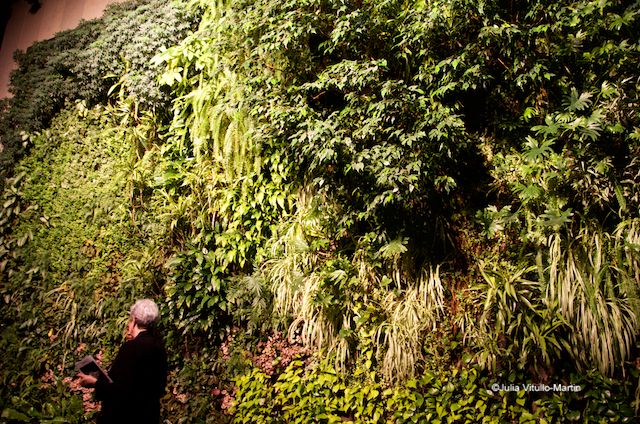 The David Rubenstein Atrium has two vertical gardens.
The David Rubenstein Atrium has two vertical gardens.
As with Lincoln center’s traffic innovations that solved historic problems once considered intractable, a public atrium successfully transformed its local, atrocious example of one of New York’s most failed programs: POPS. Privately Owned Public Spaces are a good idea that have often been implemented as virtual scams. Developers are given profitable zoning bonuses in exchange for building and maintaining a public space. The notorious Harmony Atrium was a hoax perpetrated on the public, says Levy, because it was dank, desolate, bereft of food service or proper seating, and out of compliance with New York City codes. For this the developer had been allowed to build an extra 25,314 square feet of floor area, or roughly 100 apartments.
After talking the Harmony condo into turning their atrium over to the Lincoln Center, Levy ran an architectural competition that selected Tod Williams and Billie Tsien (who also did the now lost Folk Art Museum) to overhaul the space into a combination lounge, café, meeting area, discount ticket booth, performance venue, “contemplative place to read and relax.” It is all this and more.
In 2014, JR wheat pasted not only the front of the David H. Koch Theatre, but installed a huge vinyl photograph of ballet dancers he photographed on the floor of the atrium. Meanwhile, inside the Juilliard School a wall that looks like a printout of a curtain is actually filled with quotes from Shakespeare if you look closely:


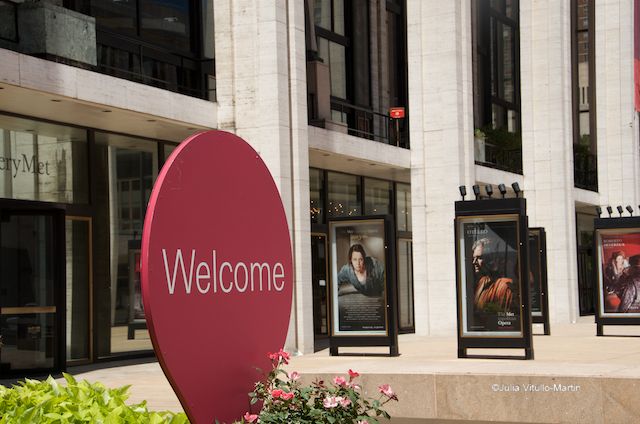 Welcome to Damrosch Park and the Metropolitan Opera
Welcome to Damrosch Park and the Metropolitan Opera
Pick up the book They Told Me not to Take that Job: Tumult, Betrayal, Heroics, and the Transformation of Lincoln Center to learn more about the history of Lincoln Center’s redevelopment. Next, read about the Top 10 Secrets of the Guggenheim Museum.
Julia Vitullo-Martin is a senior fellow at the Regional Plan Association. Get in touch with her via @JuliaManhattan.
Subscribe to our newsletter